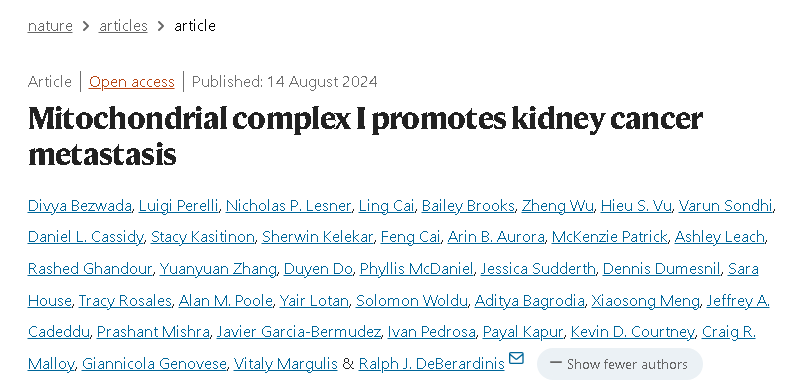Ralph DeBerardinis, Chief of the Division of Pediatric Genetics and Metabolism at the Children’s Medical Center Research Institute at UT Southwestern, shared a post on X about a recent paper by Divya Bezwada et al. published in Nature.
“Mitochondrial complex I promotes kidney cancer metastasis”
Authors: Divya Bezwada, Luigi Perelli, Nicholas Lesner, Ralph DeBerardinis et al.

“Out today in Nature, a paper from Divya Bezwada and Ralph DeBerardinis, Children’s Research Institute at UT Southwestern about metabolism in human clear cell renal cell carcinoma (ccRCC). Divya identified an unexpected metabolic change that allows these tumors to metastasize.
As with many cancers, ccRCC mortality is largely determined by whether or not the tumor metastasizes to distant organs. We need to identify molecular (including metabolic) processes that allow these tumors to metastasize.
Divya used intra-operative 13C tracing in patients to characterize tumor metabolism in vivo. We’ve used this method before to describe metabolic heterogeneity and fuel use in various cancers. But so far, only in primary tumors at the site of origin.
Divya started by infusing 13C-glucose. As predicted by many preclinical studies and our own previous work in a few patients, ccRCCs display low labeling of TCA cycle intermediates, relative to adjacent non-malignant kidney.
Divya showed that this is an intrinsic property of ccRCC, because a) not all kidney cancer subtypes have the same pattern, and b) viable slices of ccRCC tissue cultured ex vivo have the same low labeling.
Divya then infused patients with 13C-acetate and 13C-glutamine to thoroughly characterize central metabolism, including the TCA cycle. Taken together, the labeling data implied electron transport chain (ETC) dysfunction in the tumors.
This part of the analysis used a new technique that reports specific 13C positions within metabolites, thereby enhancing the information yield of isotope tracing. This helped us infer ETC dysfunction and low TCA cycle turning. Method here.
To validate the mito dysfunction, Divya and Nicholas Lesner from Shan Mishra’s Lab painstakingly isolated mitos from tumor and kidney samples and showed that tumor mitos do indeed respire poorly, with low activity of ETC complex I.
The surprise came in comparing ccRCCs in the kidney to those that had metastasized. Metastases have higher TCA cycle labeling from circulating glucose, suggesting that they regain part of their capacity for mitochondrial metabolism.
We wondered if this meant that the ETC promotes ccRCC metastasis, despite the suppression of this pathway during growth of localized ccRCCs in the kidney. But we were stuck because of a lack of good mouse models of kidney cancer metastasis.
Then we got very lucky. Giannicola Genovese and Luigi Perelli from MD Anderson Cancer Center, having read our pre-print, reached out to say they had brand new kidney cancer mouse models capable of spontaneous metastasis from the kidney, and offered to help.
I have to emphasize that this was months before Luigi’s paper on these models was published. We wouldn’t have known they’d even made the mice if they didn’t reach out. They wouldn’t have known about our work if we hadn’t posted the pre-print.
In short order, Luigi helped us show that pharmacological ETC blockade suppresses metastasis to the lung without reducing tumor growth in the kidney.
And activating the ETC, or even just activating recycling of NADH to NAD+, stimulates metastasis in tumors that normally don’t metastasize well at all. So in these mouse models, the ETC (specifically, complex I) is necessary and sufficient for metastasis.
There’s much we still don’t know. Is this a metabolic “switch,” or selection of an existing subpopulation of cells with favorable metabolic properties? What is it about complex I activity that helps cells metastasize? Is there any way to target this safely in patients?
But even so, the findings show that primary and metastastic ccRCCs *in patients* are metabolically distinct, and that analyzing human cancer metabolism using stable isotopes in the operating room can uncover metastasis-specific liabilities.
It’s also notable that the metastasis-specific liability we found is ETC complex I. We wouldn’t have predicted that in ccRCC, where a predilection for glycolysis is thought to be hard-wired by VHL loss. These are classic ‘Warburg effect’ tumors. Don’t sleep on the ETC.
We are most grateful to our Urology colleagues, especially Dr. Vitaly Margulis, and the many members of Kidney Cancer Program who participated in the study.
UT Southwestern Medical Center is an incredible place to perform this kind of multi-disciplinary, disease focused research.
More to come soon on how to use isotope tracing features in primary tumors to identify pathways that predict future metastasis and early death in patients.
And finally, congrats Divya Bezwada, now a postdoc with Benjamin Cravatt. This project required more determination, creativity, coordination and effort than I can possibly convey. Superhero stuff. Can’t wait to see what you discover next.”
Source: Ralph DeBerardinis/X
